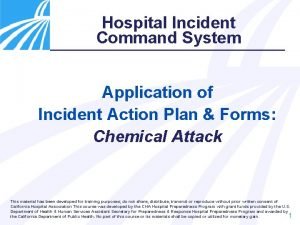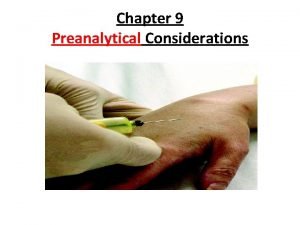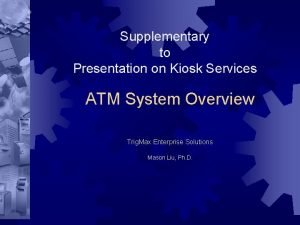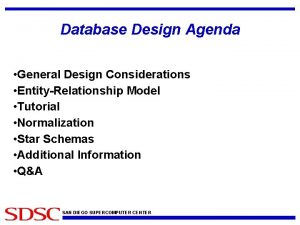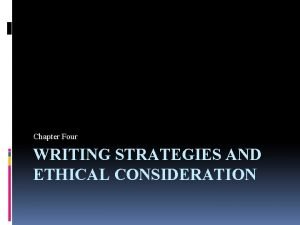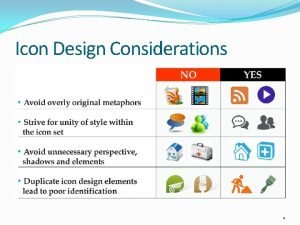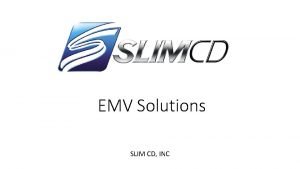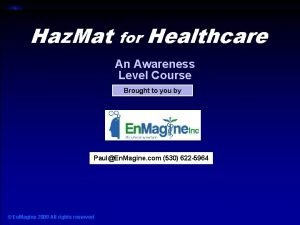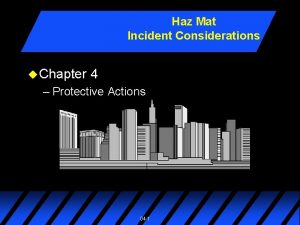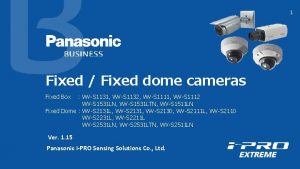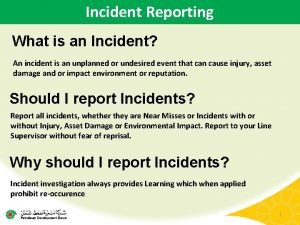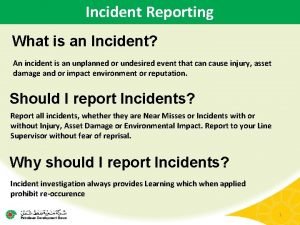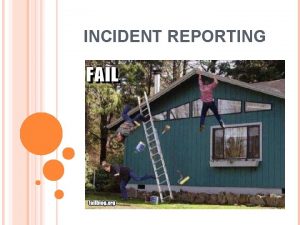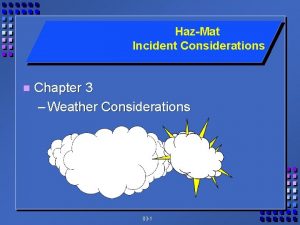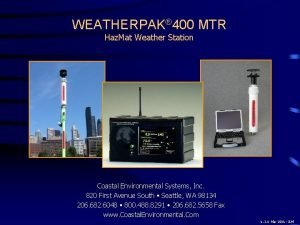Haz Mat Incident Considerations u Chapter 24 Fixed
































- Slides: 32

Haz Mat Incident Considerations u Chapter 24 – Fixed Facility Incident Consideration HMT 1 C 24 -1

Fixed Facility Incident Consideration u Session Objectives – Identify the impact of fire and safety features on the behavior of the products during an incident – Explain the significance of fire and safety features in the risk assessment process – Identify methods for determining the pressure and amount of lading in facility containers HMT 1 C 24 -2

Codes, Ordinances and Regulations u The Uniform Fire Code u Uniform Building Code u NFPA 704 - Hazard identification system HMT 1 C 24 -3

Codes, Ordinances and Regulations u Health and Safety Code u Locally adopted ordinances u SARA, Title III – Emergency planning, community right to know and emergency notification HMT 1 C 24 -4

Pre-Plan – Type(s) and amount(s) of materials – The hazards of each material – Potential health and environmental effects – In-house protection systems, utilities, and facility layout – Response routes, points of entry, barriers, emergency escape routes, and other access information HMT 1 C 24 -5

Pre-Plan u Identify potential exposure problems u Identify potential avenues of spread u Determine local capabilities and resources HMT 1 C 24 -6

The Pre-Planning Process u Identify target hazards u Compile information on target hazards HMT 1 C 24 -7

Sources of information include: u Building permits u Inspection reports u Hazardous materials permits u Past incident reports u Hazardous Materials Management Plan HMT 1 C 24 -8

Hazardous Materials Management Plans (HMMPs) u Developed and maintained by personnel at the fixed facility u Must be given to the agency having emergency response authority u Required HMT 1 C 24 -9

HMMP Must Contain: – General Information – Facility Storage Map – Hazardous Materials Inventory Statement – Separation of materials – Monitoring Program – Record Keeping Forms – Emergency Equipment – Emergency Response Plans HMT 1 C 24 -10

Pre-Plans u. A pre-plan usually consists of two parts: – Quick access information – Plot plan u Pre-plans should be set up in a standard format for all fixed facilities – exercise the plan HMT 1 C 24 -11

Fixed Facility Systems u Containers and tanks u Piping, valves and fittings u Signage u Security u Ignition sources u Shelf storage u Spill control, drainage and containment u Ventilation HMT 1 C 24 -12

Fixed Facility Systems u Separation from incompatible hazardous materials u Hazardous materials storage cabinets u Fire extinguishing systems u Explosion venting or suppression u Standby power u Limit controls u Manual alarm HMT 1 C 24 -13

Fixed Facility Systems u Supervision u Emergency vehicle access u Toxic gas storage u Gas detection u Local gas shut off u Automatic shut off u Enunciator panel HMT 1 C 24 -14

Fixed Facility Containers HMT 1 C 24 -15

Fixed Facility Containers u Non-bulk containers u Intermediate bulk containers u Fixed storage tanks – Underground tanks – Above ground tanks HMT 1 C 24 -16

Hazardous Materials Storage Tank Regulations u Uniform Building Code (UBC) u Uniform Fire Code (UFC) u Occupational Safety and Health Administration (OSHA) u Locally adopted Hazardous Materials Storage Ordinances (HMSO) HMT 1 C 24 -17

Vertical Atmospheric Fixed Roof Tanks HMT 1 C 24 -18

Vertical Atmospheric Fixed Roof Tanks u Wider then they are tall u Fat roof or an inverted cone shaped roof u May be designed with weak roof-toshell attachments u Usually contain flammable, combustible and corrosive liquids HMT 1 C 24 -19

Floating-Roof Tanks u Very large tanks u Roofs float on liquid inside – limits the vapor space u Designed for flammable and combustible liquids that readily vaporize HMT 1 C 24 -20

Covered Floating-Roof Tanks u Fixed roof with a inner floating roof u Can be identified by large vent openings around the top of the tank u Designed to contain flammable and combustible liquids HMT 1 C 24 -21

Vertical Low Pressure Fixed. Roof Tanks u Taller than they are wide u Dome top – designed to accommodates changes in vapor pressure u Operate at pressures up to 15 psig u Used for flammable and combustible liquids and other types of haz mats HMT 1 C 24 -22

Horizontal Above Ground Low Pressure Storage Tanks u Above ground tanks that lay horizontally u Potential problems include: – possible failure of supports during a fire – possible inadequate venting u Generally contain gasoline, naphtha or fuel oil HMT 1 C 24 -23

Pressure Horizontal Tank u Cylindrical with rounded ends u Usually mounted horizontally on concrete foundation walls or legs u Generally painted white or another highly reflective color u Contain liquefied gases u May have built-in protection systems HMT 1 C 24 -24

Spherical Tanks u Ball-like shape u Contain high pressure gases u Painted white or other reflective color u Pressure relief valve at the top – No pressure relief valve may indicate cryogenic liquids HMT 1 C 24 -25

Cryogenic Liquid Tanks u Taller than they are wide, and have domed tops u Rest on legs rather than directly on the ground u Store cryogenic liquids HMT 1 C 24 -26

Underground Storage Tanks u Underground storage tanks are at least partially below ground u Advantages - protected from fire and mechanical damage u Disadvantage - cannot be visually inspected for leaks u Subject to corrosion u Contain LPG, gasoline or fuel oil HMT 1 C 24 -27

Bulk Storage Facilities u Safety features that can be found at Bulk Storage Facilities: – Tank Spacing – Drainage Control and Diking – Venting Systems – Monitoring and Detection Systems – Fire Protection Systems – Transfer Options HMT 1 C 24 -28

Fixed Facility Haz Mat Incident Management u Review pre-plans while en route u Determine the best approach route and notify other responding units u Establish Command u Conduct safe size-up u Contact site personnel for information HMT 1 C 24 -29

Fixed Facility Haz Mat Incident Management u Determine if a rescue is involved u Isolate the area u Request assistance as needed u Establish control zones u Have responsible party respond u Identify hazards present at the site HMT 1 C 24 -30

Fixed Facility Haz Mat Incident Management u Alert hospitals if necessary u Consider protective actions u Establish the level of PPE u Contain the material using appropriate measures u Decontaminate personnel, victims and equipment u Owner is responsible for clean up HMT 1 C 24 -31

Incidents With Fire Involvement: u Extinguish vs. let it burn u Steam may volatize and spread contaminants u Use foam, dry chemical or carbon dioxide as appropriate u Oxidizers are difficult extinguish HMT 1 C 24 -32
 Incident objectives that drive incident operations
Incident objectives that drive incident operations Secondary reinforcer
Secondary reinforcer Secondary reinforcer
Secondary reinforcer Fixed ratio fixed interval
Fixed ratio fixed interval Fixed order quantity vs fixed time period
Fixed order quantity vs fixed time period The fpga is a fixed-function device
The fpga is a fixed-function device Basal state blood collection
Basal state blood collection What are the general considerations in machine design?
What are the general considerations in machine design? Tax considerations for setting up a new business
Tax considerations for setting up a new business Atm kiosk solution
Atm kiosk solution Exchange transaction and relationship in marketing
Exchange transaction and relationship in marketing Mechanical considerations of transmission line
Mechanical considerations of transmission line Database design considerations
Database design considerations Psychomotor considerations language acquisition
Psychomotor considerations language acquisition What is cloud delivery model
What is cloud delivery model Writing strategies and ethical considerations
Writing strategies and ethical considerations Bioreactor considerations for animal cell culture
Bioreactor considerations for animal cell culture Collaboration design considerations
Collaboration design considerations Fpd tooth preparation
Fpd tooth preparation Anatomical considerations
Anatomical considerations Biopharmaceutic considerations in drug product design
Biopharmaceutic considerations in drug product design Retromylohyoid ridge
Retromylohyoid ridge Dogso e spa
Dogso e spa Myharper blackboard
Myharper blackboard Environmental considerations pdhpe
Environmental considerations pdhpe Natalya hasan
Natalya hasan Quasi experimental design ethical issues
Quasi experimental design ethical issues Slim cd inc
Slim cd inc Design considerations for mobile computing
Design considerations for mobile computing Appendices sample
Appendices sample High flow versus low flow oxygen
High flow versus low flow oxygen Ethical considerations examples
Ethical considerations examples Examples of consideration
Examples of consideration
